2008 FORD F SERIES MOTORHOME AND COMMERCIAL CHASSIS jump start
[x] Cancel search: jump startPage 1 of 130
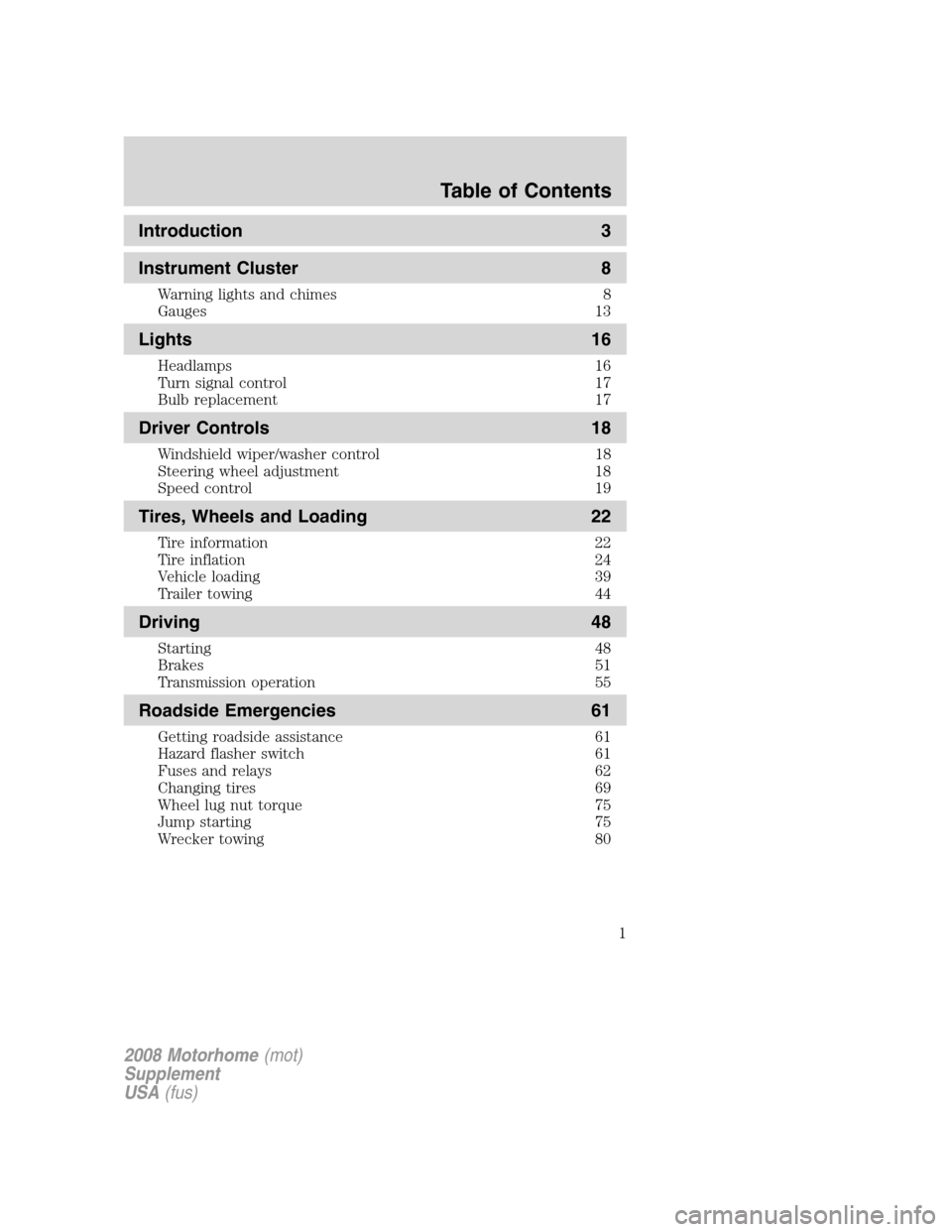
Introduction 3
Instrument Cluster 8
Warning lights and chimes 8
Gauges 13
Lights 16
Headlamps 16
Turn signal control 17
Bulb replacement 17
Driver Controls 18
Windshield wiper/washer control 18
Steering wheel adjustment 18
Speed control 19
Tires, Wheels and Loading 22
Tire information 22
Tire inflation 24
Vehicle loading 39
Trailer towing 44
Driving 48
Starting 48
Brakes 51
Transmission operation 55
Roadside Emergencies 61
Getting roadside assistance 61
Hazard flasher switch 61
Fuses and relays 62
Changing tires 69
Wheel lug nut torque 75
Jump starting 75
Wrecker towing 80
Table of Contents
1
2008 Motorhome(mot)
Supplement
USA(fus)
Page 61 of 130
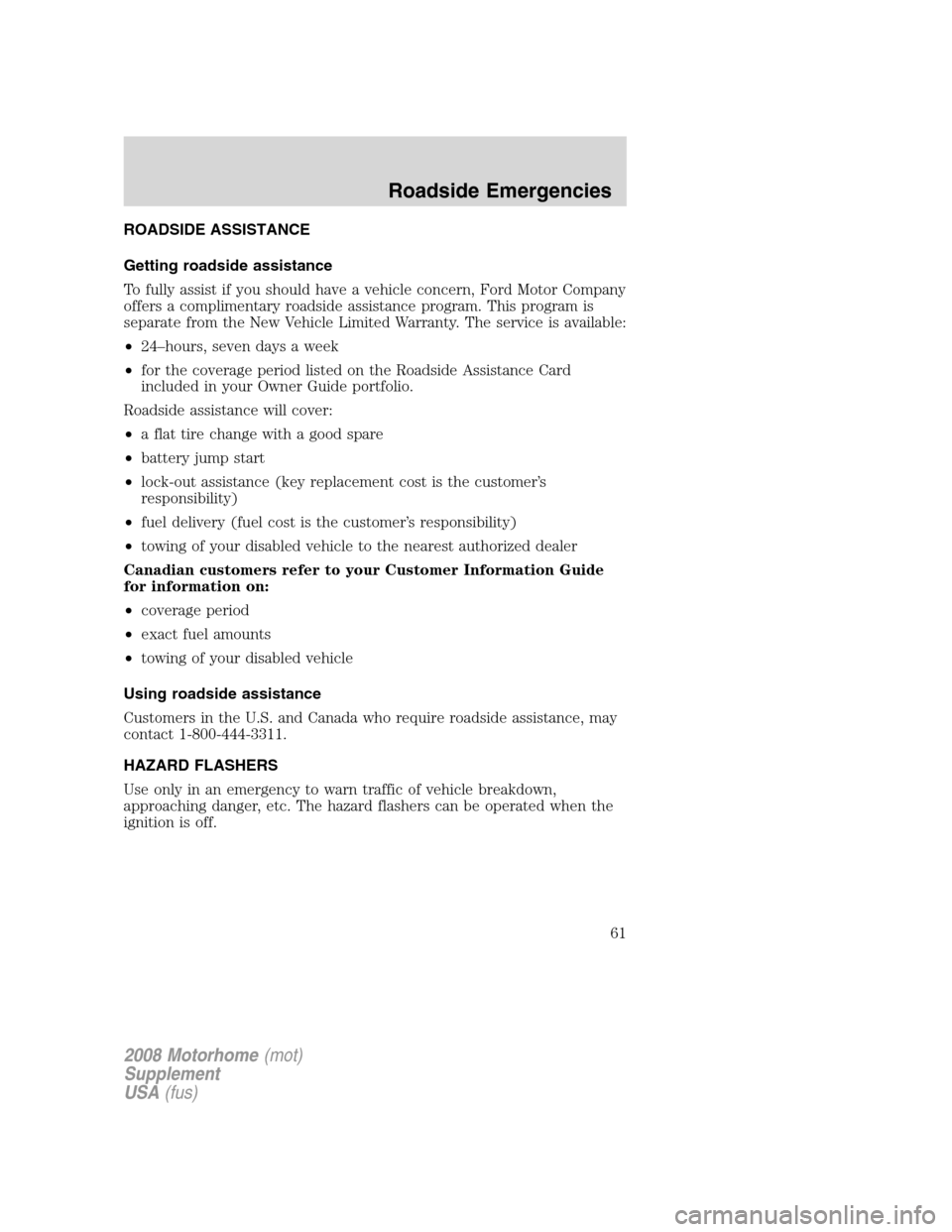
ROADSIDE ASSISTANCE
Getting roadside assistance
To fully assist if you should have a vehicle concern, Ford Motor Company
offers a complimentary roadside assistance program. This program is
separate from the New Vehicle Limited Warranty. The service is available:
•24–hours, seven days a week
•for the coverage period listed on the Roadside Assistance Card
included in your Owner Guide portfolio.
Roadside assistance will cover:
•a flat tire change with a good spare
•battery jump start
•lock-out assistance (key replacement cost is the customer’s
responsibility)
•fuel delivery (fuel cost is the customer’s responsibility)
•towing of your disabled vehicle to the nearest authorized dealer
Canadian customers refer to your Customer Information Guide
for information on:
•coverage period
•exact fuel amounts
•towing of your disabled vehicle
Using roadside assistance
Customers in the U.S. and Canada who require roadside assistance, may
contact 1-800-444-3311.
HAZARD FLASHERS
Use only in an emergency to warn traffic of vehicle breakdown,
approaching danger, etc. The hazard flashers can be operated when the
ignition is off.
2008 Motorhome(mot)
Supplement
USA(fus)
Roadside Emergencies
61
Page 75 of 130
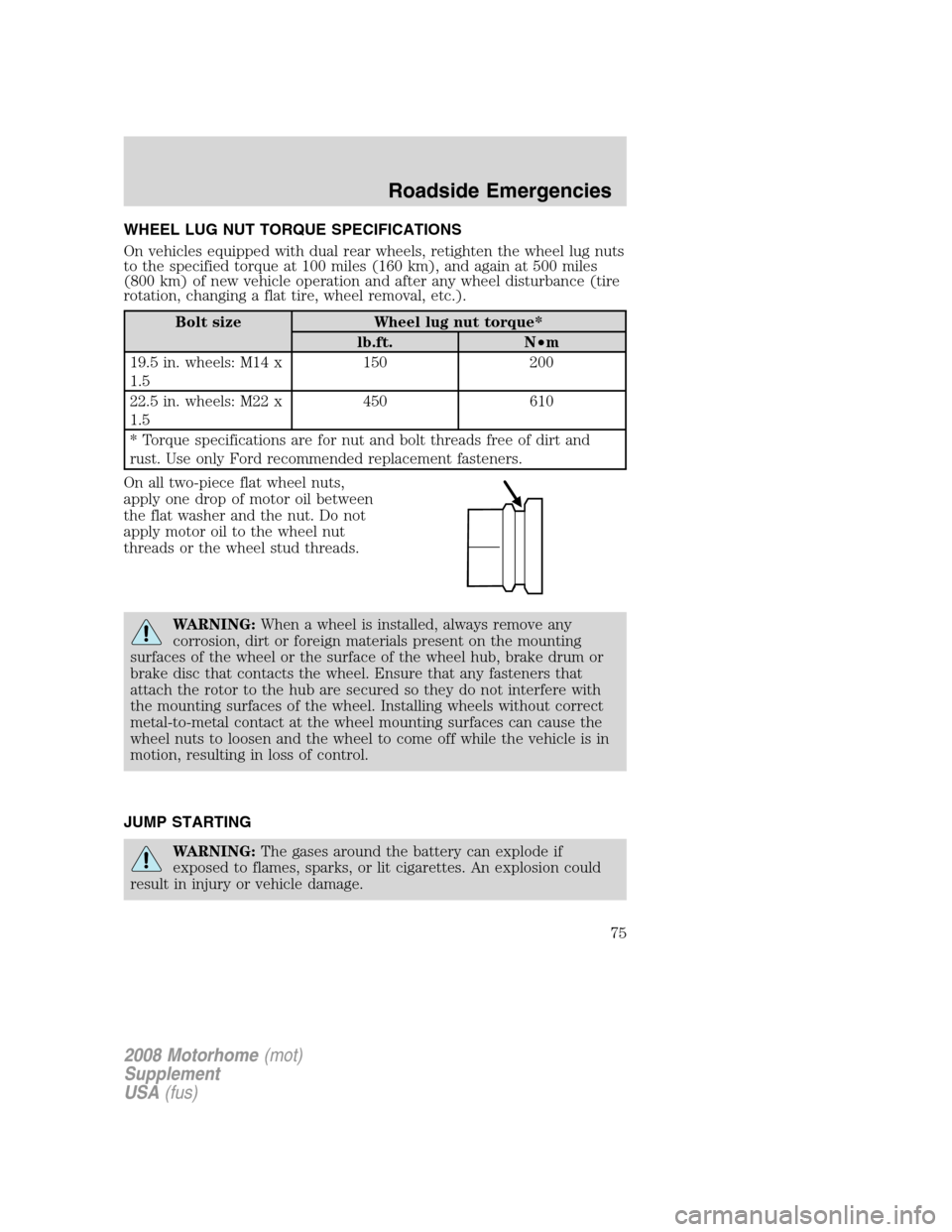
WHEEL LUG NUT TORQUE SPECIFICATIONS
On vehicles equipped with dual rear wheels, retighten the wheel lug nuts
to the specified torque at 100 miles (160 km), and again at 500 miles
(800 km) of new vehicle operation and after any wheel disturbance (tire
rotation, changing a flat tire, wheel removal, etc.).
Bolt size Wheel lug nut torque*
lb.ft. N•m
19.5 in. wheels: M14 x
1.5150 200
22.5 in. wheels: M22 x
1.5450 610
* Torque specifications are for nut and bolt threads free of dirt and
rust. Use only Ford recommended replacement fasteners.
On all two-piece flat wheel nuts,
apply one drop of motor oil between
the flat washer and the nut. Do not
apply motor oil to the wheel nut
threads or the wheel stud threads.
WARNING:When a wheel is installed, always remove any
corrosion, dirt or foreign materials present on the mounting
surfaces of the wheel or the surface of the wheel hub, brake drum or
brake disc that contacts the wheel. Ensure that any fasteners that
attach the rotor to the hub are secured so they do not interfere with
the mounting surfaces of the wheel. Installing wheels without correct
metal-to-metal contact at the wheel mounting surfaces can cause the
wheel nuts to loosen and the wheel to come off while the vehicle is in
motion, resulting in loss of control.
JUMP STARTING
WARNING:The gases around the battery can explode if
exposed to flames, sparks, or lit cigarettes. An explosion could
result in injury or vehicle damage.
2008 Motorhome(mot)
Supplement
USA(fus)
Roadside Emergencies
75
Page 78 of 130

4. Make the final connection of the negative (-) cable to an exposed
metal part of the stalled vehicle’s engine, away from the battery and the
carburetor/fuel injection system.Do notuse fuel lines, engine rocker
covers or the intake manifold asgroundingpoints.
WARNING:Do not connect the end of the second cable to the
negative (-) terminal of the battery to be jumped. A spark may
cause an explosion of the gases that surround the battery.
5. Ensure that the cables are clear of fan blades, belts, moving parts of
both engines, or any fuel delivery system parts.
Jump starting
1. Start the engine of the booster vehicle and run the engine at
moderately increased speed.
2. Start the engine of the disabled vehicle.
3. Once the disabled vehicle has been started, run both engines for an
additional three minutes before disconnecting the jumper cables.
+–+–
2008 Motorhome(mot)
Supplement
USA(fus)
Roadside Emergencies
78
Page 80 of 130

4. Remove the jumper cable from the positive (+) terminal of the
disabled vehicle’s battery.
After the disabled vehicle has been started and the jumper cables
removed, allow it to idle for several minutes so the engine computer can
relearnits idle conditions.
WRECKER TOWING
If you need to have your vehicle towed, contact a professional towing
service or, if you are a member of a roadside assistance program, your
roadside assistance service provider.
It is recommended that your vehicle be towed with a wheel lift (with the
rear wheels on the ground and the front wheels off the ground) or
flatbed equipment.
To avoid transmission damage when towing your vehicle from the front
with the rear wheels on the ground, do not exceed a maximum distance
of 50 miles (80 km) and a maximum speed of 35 mph (56 km/h). If the
maximum distance or speed will be exceeded, the driveshaft must be
removed by a qualified technician or transmission damage will result.
If the vehicle is towed by other means or incorrectly, vehicle
damage may occur.
When calling for a tow truck, tell the operator what kind of vehicle you have.
Emergency towing
In case of a roadside emergency with a disabled vehicle (without access
to wheel dollies, car hauling trailer, or flatbed transport vehicle) your
vehicle (regardless of transmission powertrain configuration) can be flat
towed (all wheels on the ground) under the following conditions:
•
Vehicle is facing forward so that it is being towed in a forward direction.
•Place the transmission in N (Neutral).
•Maximum speed is not to exceed 35 mph (56 km/h).
•Maximum distance is 50 miles (80 km).
+–+–
2008 Motorhome(mot)
Supplement
USA(fus)
Roadside Emergencies
80
Page 126 of 130
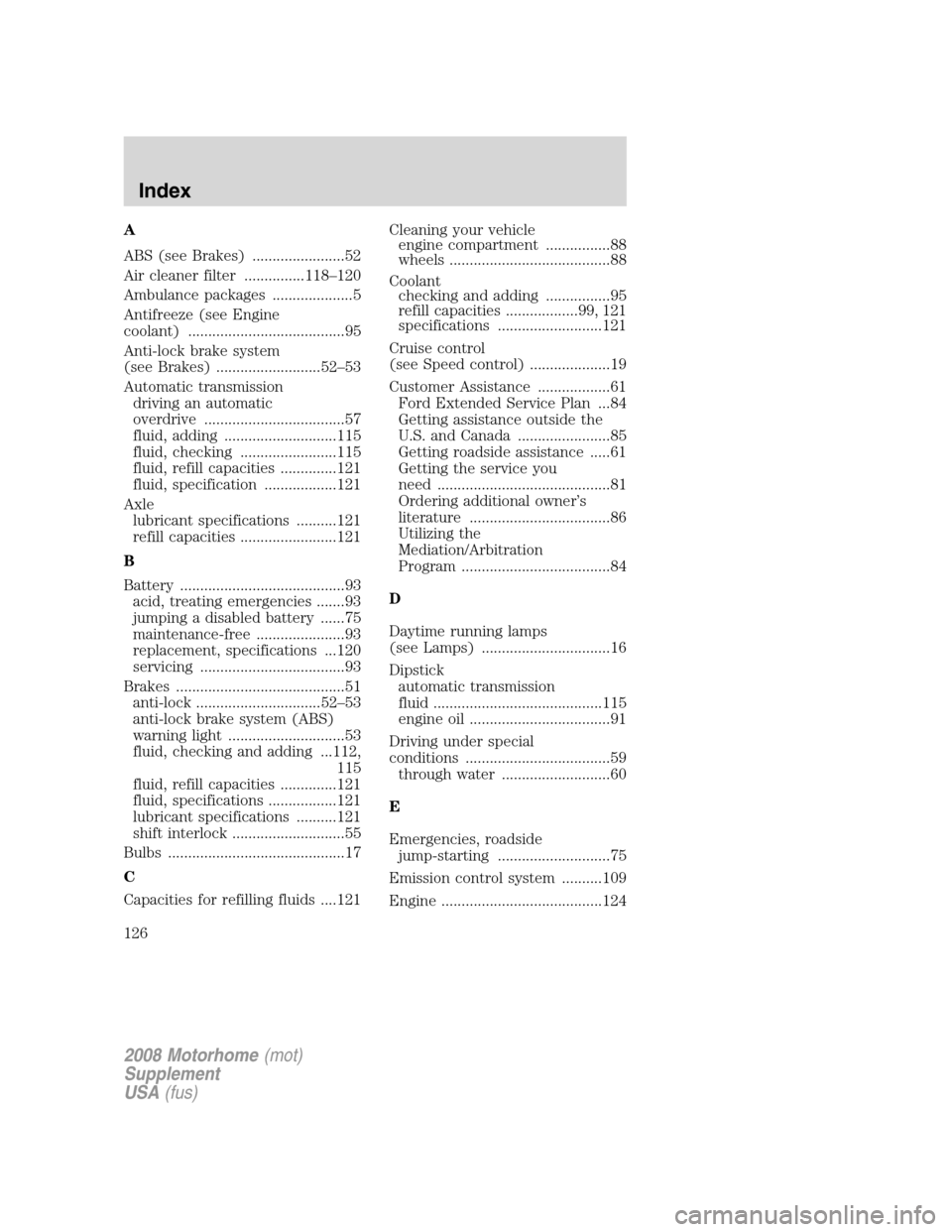
A
ABS (see Brakes) .......................52
Air cleaner filter ...............118–120
Ambulance packages ....................5
Antifreeze (see Engine
coolant) .......................................95
Anti-lock brake system
(see Brakes) ..........................52–53
Automatic transmission
driving an automatic
overdrive ...................................57
fluid, adding ............................115
fluid, checking ........................115
fluid, refill capacities ..............121
fluid, specification ..................121
Axle
lubricant specifications ..........121
refill capacities ........................121
B
Battery .........................................93
acid, treating emergencies .......93
jumping a disabled battery ......75
maintenance-free ......................93
replacement, specifications ...120
servicing ....................................93
Brakes ..........................................51
anti-lock ...............................52–53
anti-lock brake system (ABS)
warning light .............................53
fluid, checking and adding ...112,
115
fluid, refill capacities ..............121
fluid, specifications .................121
lubricant specifications ..........121
shift interlock ............................55
Bulbs ............................................17
C
Capacities for refilling fluids ....121Cleaning your vehicle
engine compartment ................88
wheels ........................................88
Coolant
checking and adding ................95
refill capacities ..................99, 121
specifications ..........................121
Cruise control
(see Speed control) ....................19
Customer Assistance ..................61
Ford Extended Service Plan ...84
Getting assistance outside the
U.S. and Canada .......................85
Getting roadside assistance .....61
Getting the service you
need ...........................................81
Ordering additional owner’s
literature ...................................86
Utilizing the
Mediation/Arbitration
Program .....................................84
D
Daytime running lamps
(see Lamps) ................................16
Dipstick
automatic transmission
fluid ..........................................115
engine oil ...................................91
Driving under special
conditions ....................................59
through water ...........................60
E
Emergencies, roadside
jump-starting ............................75
Emission control system ..........109
Engine ........................................124
2008 Motorhome(mot)
Supplement
USA(fus)
Index
126
Page 127 of 130

cleaning .....................................88
coolant .......................................95
fail-safe cooling .......................100
idle speed control .....................93
lubrication specifications .......121
refill capacities ........................121
service points ............................90
Engine oil ....................................91
checking and adding ................91
dipstick ......................................91
filter, specifications ..........92, 120
recommendations .....................92
refill capacities ........................121
specifications ..........................121
Event data recording ....................5
Exhaust fumes ............................50
F
Fail safe cooling ........................100
Fluid capacities .........................121
Fuel ............................................101
calculating fuel economy .......105
capacity ...................................121
choosing the right fuel ...........104
comparisons with EPA fuel
economy estimates .................108
detergent in fuel .....................105
filling your vehicle with
fuel ...................................101, 106
filter, specifications ........101, 120
improving fuel economy ........105
octane rating ...................104, 124
quality ......................................104
running out of fuel .................105
safety information relating to
automotive fuels .....................101
Fuses ............................................62G
Gas mileage (see Fuel
economy) ...................................105
Gauges .........................................13
transmission fluid
temperature gauge ...................16
H
Hazard flashers ...........................61
Headlamps ...................................16
daytime running lights .............16
flash to pass ..............................17
high beam .................................16
turning on and off ....................16
I
Ignition .................................48, 124
Inspection/maintenance (I/M)
testing ........................................110
Instrument panel
cluster ..........................................8
lighting up panel and
interior .......................................17
J
Jump-starting your vehicle ........75
K
Keys
positions of the ignition ...........48
L
Lamps
daytime running light ...............16
headlamps .................................16
2008 Motorhome(mot)
Supplement
USA(fus)
Index
127
Page 128 of 130
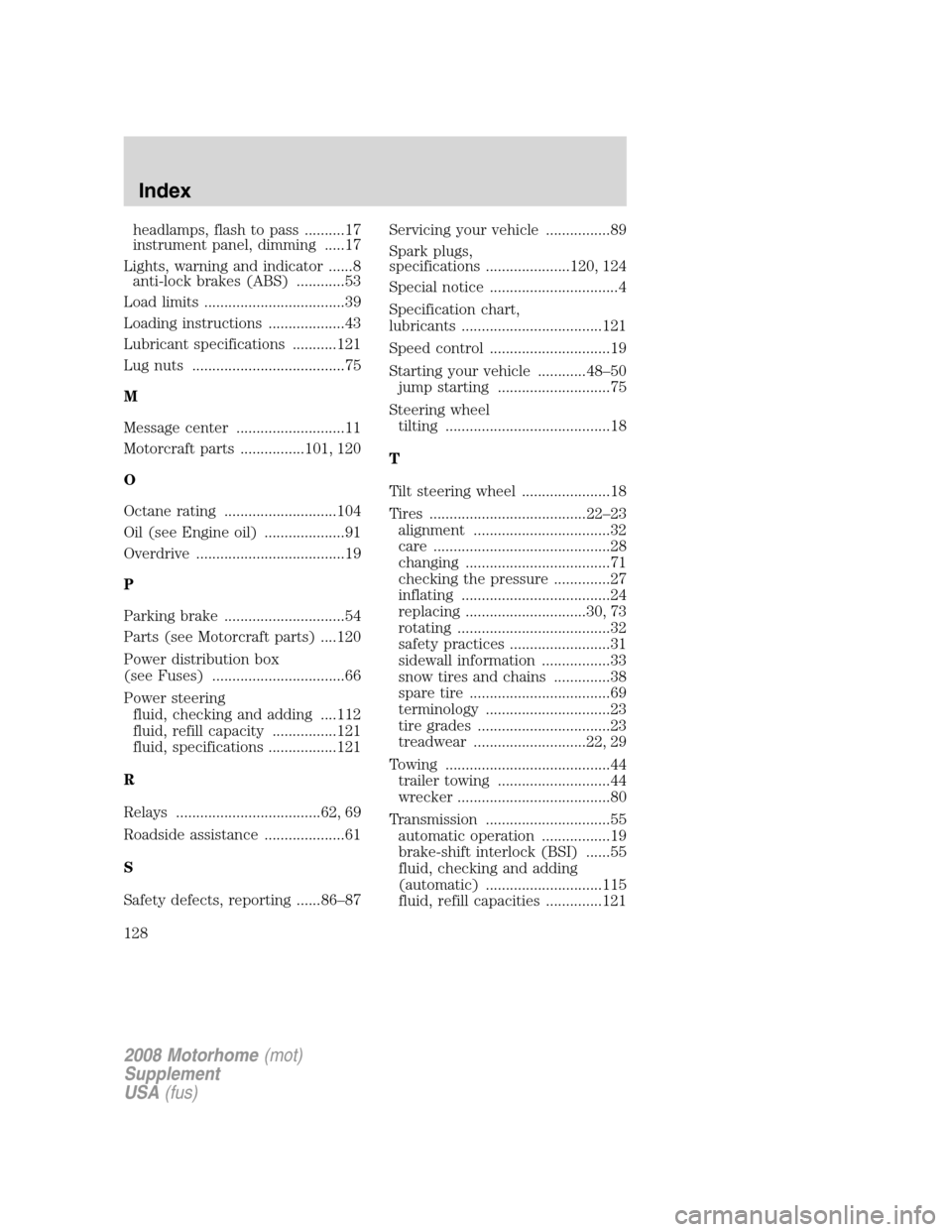
headlamps, flash to pass ..........17
instrument panel, dimming .....17
Lights, warning and indicator ......8
anti-lock brakes (ABS) ............53
Load limits ...................................39
Loading instructions ...................43
Lubricant specifications ...........121
Lug nuts ......................................75
M
Message center ...........................11
Motorcraft parts ................101, 120
O
Octane rating ............................104
Oil (see Engine oil) ....................91
Overdrive .....................................19
P
Parking brake ..............................54
Parts (see Motorcraft parts) ....120
Power distribution box
(see Fuses) .................................66
Power steering
fluid, checking and adding ....112
fluid, refill capacity ................121
fluid, specifications .................121
R
Relays ....................................62, 69
Roadside assistance ....................61
S
Safety defects, reporting ......86–87Servicing your vehicle ................89
Spark plugs,
specifications .....................120, 124
Special notice ................................4
Specification chart,
lubricants ...................................121
Speed control ..............................19
Starting your vehicle ............48–50
jump starting ............................75
Steering wheel
tilting .........................................18
T
Tilt steering wheel ......................18
Tires .......................................22–23
alignment ..................................32
care ............................................28
changing ....................................71
checking the pressure ..............27
inflating .....................................24
replacing ..............................30, 73
rotating ......................................32
safety practices .........................31
sidewall information .................33
snow tires and chains ..............38
spare tire ...................................69
terminology ...............................23
tire grades .................................23
treadwear ............................22, 29
Towing .........................................44
trailer towing ............................44
wrecker ......................................80
Transmission ...............................55
automatic operation .................19
brake-shift interlock (BSI) ......55
fluid, checking and adding
(automatic) .............................115
fluid, refill capacities ..............121
2008 Motorhome(mot)
Supplement
USA(fus)
Index
128